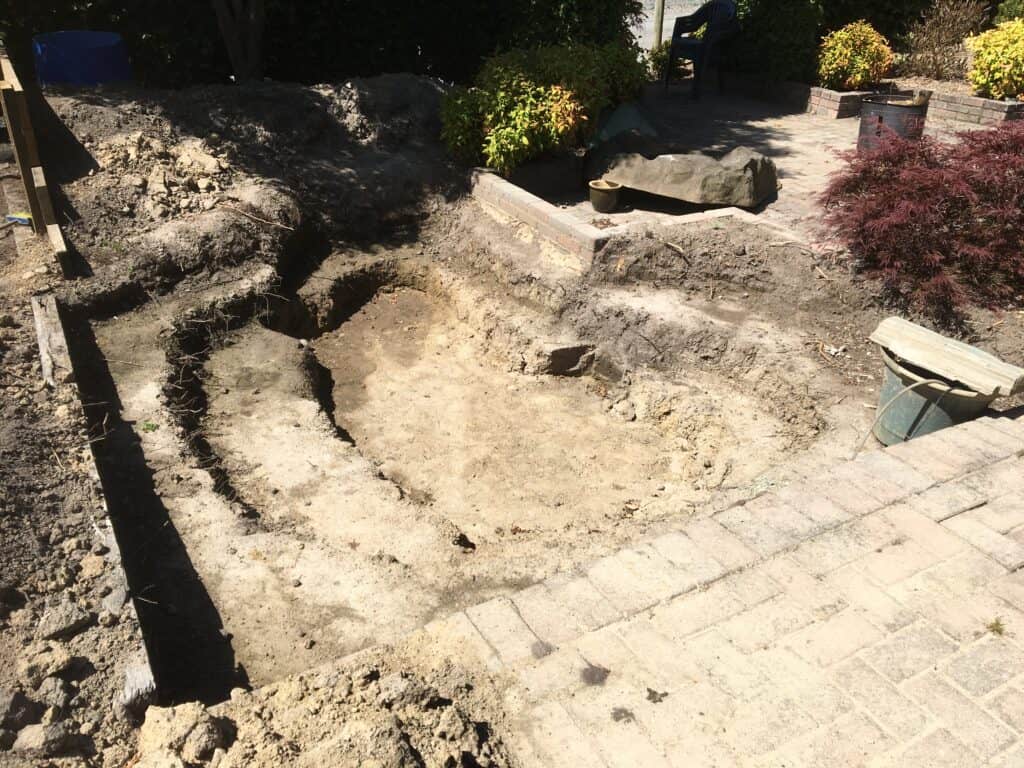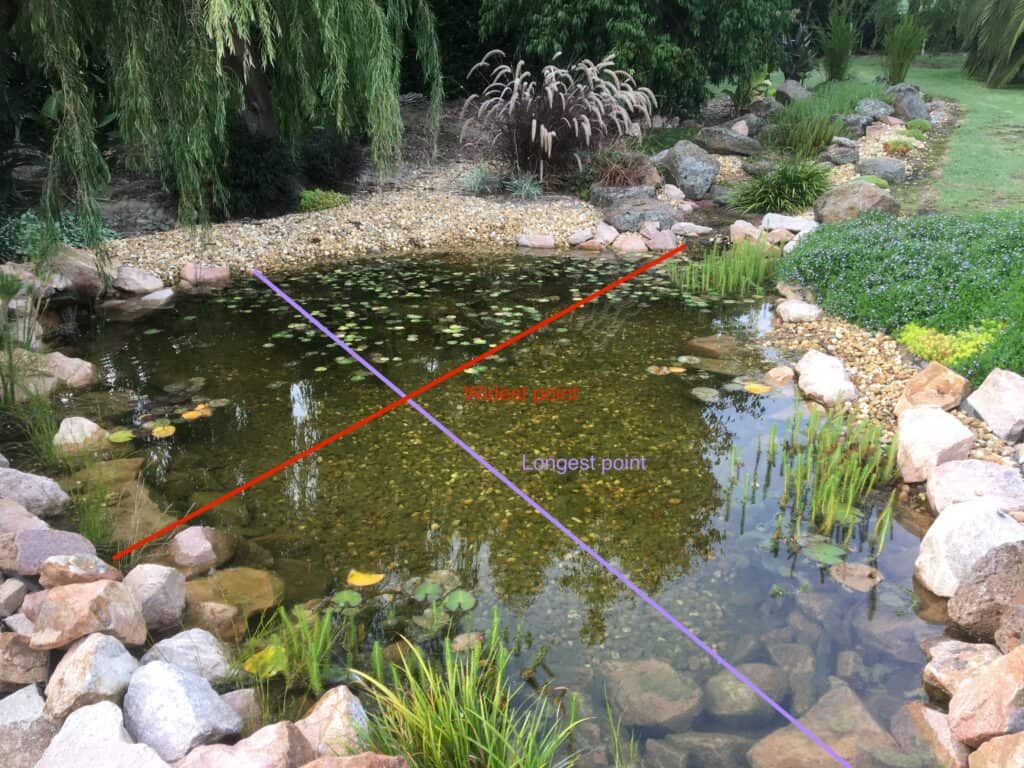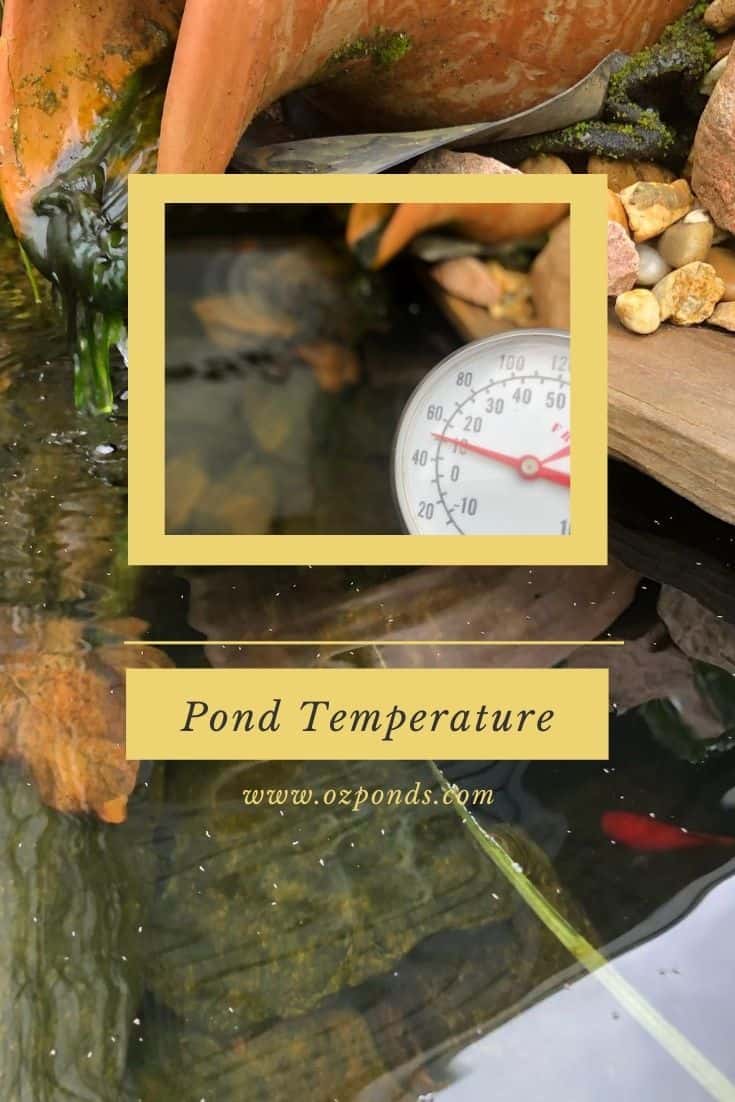The temperature of your fish pond is important as it will determine what type of fish you can keep.
There are pond fish for any pond. From the hot and humid tropics, to ponds that freeze over in winter and everything in-between.
Maintaining a stable temperature is also critical to maintaining optimal fish health.
As the seasons change there are different things we need to be aware of, especially when it comes to feeding.
First let me explain the importance of a stable temperature and how to achieve it.
Avoiding temperature swings
To avoid temperature swings in your fish pond there are 3 things to consider Depth, Volume and shade.
As the seasons change so too does the temperature. Water heats and cools much slower than the surrounding air.
It is ok for the pond to have a different temperature in summer as it does in winter.
What we need to avoid is sudden temperature fluctuations.
A sudden temperature drop will stress fish out and can lead to death.
Fish stress along with poor water quality are common reasons that pond fish become ill or worse.
If you want to keep water quality optimal read our article on wetland/bog filtration (its the most natural and cost effective way to filter pond water).
Depth
First let’s talk about depth.
A deeper pond has advantages over a shallow pond when it comes to temperature fluctuations.
In summer a deeper pond will have cooler water on the bottom. Then in winter the warmer water is on the bottom.
Water heats and cools much slower than air so a deep pond is advantageous in both winter and summer temperature extremes.
Thats why depth is so important!

Volume
Because water heats and cools slowly, overall volume of the water in your pond also effects the temperature.
Think of it like this if you put a small amount of water in a kettle it boils faster than a full kettle.
Your pond is exactly the same!
A small volume of water will heat and cool quickly. Whilst a larger volume will heat and cool much slower.
A greater volume of water will allow the fish to gradually adjust to outside temperature extremes, rather than it being almost instantaneous and very stressful.
Simply adding depth to a planned fish pond project is a great way to increase overall volume of water without increasing the footprint of the pond.
Most jurisdictions don’t have any depth restrictions on ponds as they are not classed the same way as a swimming pool.
But always check with your local authorities just to be sure.
Small/ shallow ponds really need to be kept in the shade. This stops them from rapidly heating and cooling.

Shade
We all know how hot the summer sun can be!
In summer the water in a pond can heat up very rapidly. While overnight the temperature is often quite mild.
If the pond is smaller this all happens far too quick. For this reason i keep any ponds under 60cm (2ft) deep in the shade.
Even larger ponds with plenty of circulation will benefit from shade during the summer months.
The easiest way to provide shade is adding water lilies, or other floating plants.
Keeping your pond fish happy as the temperatures change
Summer
Summer is my favourite time in the pond. The water lily’s are flowering, dragonfly are about and the fish are really active. The long days allow more time to enjoy the pond after work.
As the temperature of the pond water increases the amount of oxygen in the water decreases. During summer running an extra pond pump or aerator to supplement oxygen in the pond will keep your fish healthy.
Autumn
During fall the leaves start to become a nuisance. Be sure to add a leaf net, empty your skimmer regularly or scoop them out with a net.
Decomposing leaf matter can lead to algae spikes and a decrease in oxygen levels in the water.
With the falling temperatures its important to monitor what and how much you feed your fish. Once the temperature dips below 15C (59F) its time to switch the fish food to a cold water mix.
Cold water fish food is a more wheat based formula that is more easily digested by the fish in cooler temperatures.
If the temperature dips below 10C (50F) stop feeding completely its time for the fish to start hibernating for winter.
A pond thermometer will help you decided when its time to switch fish foods and when to stop feeding altogether.
Winter
Depending on where you live winter can be a bleak time in the pond. Here our pond doesn’t freeze, but the fish slow right down.
If you are in an area where the surface of the pond freezes you’ll need to keep a permanent hole in the ice. This can be achieved with a powerful submersible pond pump or a pond de-icer. A hole in the ice is critical for oxygen to enter the water.
Another tip is to shut down any fountains and steams. While iced over waterfalls look spectacular the constant flow of water in contact with the chilly air will drop the temperature in the pond even more.
Winter is another great time to run your pond aerator especially while any fountains and streams are turned off.
Spring
Now things start ramping up again. Once the temperature in the pond is constantly above 10C (50F) you can begin feeding the fish with the cold water, wheat based food.
As soon as the water is above 15C (59F) you can return to a premium high protein diet.
During spring is also a good time to add some extra beneficial bacteria to your pond. As the water temperatures rise and the plants begin to grow algae can rear its ugly head.
Adding some beneficial bacteria should help keep it at bay.
Temperature and what fish you can keep ?
Warm ponds
In ponds where the temperature never drops below 20C (68F) you should be able to keep an incredibly wide variety of pond fish.
You’ll be able to keep basically any variety of freshwater tropical fish sold for the aquarium trade.
Tropical fish usually very colourful and active.
Popular tropical pond fish are guppies, mollies and platy’s. These varieties are incredibly popular and breed like rabbits!
They produce live young rather than eggs. These live bearer fish are nice and small and will suit any sized ponds.
Keep in mind that your filtration system will need to be adequate to deal with all the babies!
As i mention over and over again, the best filter is a wetland or bog filter. Easy to make yourself, cheap and almost no maintenance.
Warm ponds can also keep goldfish and koi. But be sure to provide plenty of shade for your pond.
Goldfish and koi do come from a more temperate-cold climate and don’t enjoy overly warm water avoid temperatures above 30C (86F).
Cool ponds
In more temperate areas where the water temperature doesn’t dip below 10C (50F) you still have a good deal of options.
For small ponds my favourite little fish is the white cloud mountain minnow. This fish is sometimes referred to as the poor mans neon. Neon tetras won’t survive outside in temperate ponds but the white cloud will.
These little fish love to school and breed easily. They are hardy and often sold as a beginners fish in the aquarium trade.
You won’t need to feed these little fish as they are veracious feeders, eating anything that fits in their mouths.
Ponds in temperate climates are perfect for goldfish and koi. As the water won’t freeze over the fish will always be visible and active.
In winter they will slow down and if the temperate in the pond drops below 10C (50F) stop feeding!
Cold ponds
In ponds where the temperatures dip below freezing you can still keep goldfish and koi in your pond.
They are a popular choice in all climates because they are so colourful and easy to spot in your pond.
The pond will need to be deep enough so it doesn’t freeze solid and a hole in the ice will need to be maintained to allow for oxygen.
Using a special pump can be useful during winter.
Keeping the fish healthy in the lead up to winter with a cold water fish food can be beneficial.
Another option for a cold climate pond are trout. Trout thrive in cold water.
Just be aware they will need plenty of oxygen as they are accustomed to living in fast moving streams.
What temperature should a pond be?
There is no specific temperature that a pond “should be”. Of course if keeping tropical fish you’ll need a warm pond.
But keeping a pond warm when the climate is working against you is a costly endeavour.
Also keeping cold water fish like trout in the tropics is a pointless exercise.
You are much better off selecting fish that are suited to your climate.
As i mentioned at the very beginning of this article avoiding rapid fluctuations in temperature, should be the main focus.
How does temperature affect a pond?
There is a few ways that the temperature of the water will impact on your pond.
Number 1 is warm water will be more conducive to algae blooms.
Algae will grow and multiply rapidly in warm water.
To help prevent this insure your pond has a good depth, 60cm (2ft) or more. Provide shade, this can be by trees or floating water plants.
Algae like most plants thrives on light and warmth eliminate these and algae shouldn’t be a problem.
Number 2 is rapid temperature fluctuation are a cause of fish stress.
Providing good pond depth, overall water volume and shade can help minimise the amount the temperature of the pond will fluctuate.
Number 3 is feeding.
The temperature of the pond will dictate how active the fish are.
We never want to be feeding the fish when their metabolism isn’t firing. They wont be able digest the food properly.
Koi and goldfish shouldn’t be feed once the temperature drops below 10C (50F).
Fish like trout will remain active in very low temperatures and slow down in warm temperatures.
Meanwhile tropical fish are always active.
How do you control the temperature of a pond?
The best way to maintain a reasonably stable pond temperature is to dig the pond into the ground.
I aim for at least 60cm (2ft). If the ground freezes go even deeper.
The surrounding ground helps to insulate the pond and is much cheaper than purchasing insulation for a pond built above ground.
Another thing, the bigger the pond the more stable the water temperature will be.
As i mentioned earlier water heats and cools slowly. Therefore the more water the longer it takes to fluctuate.
Lastly is shade. Direct sunlight is hot!
If the suns rays are beaming down directly into the pond it will heat it quite rapidly.
Adding plants or shade sails in summer will definitely help control the temperature from getting to hot in summer.
Subscribe
Quite often pond suppliers offer me special offers and discounts. I love sharing these with you guys.
If you would like to receive special discounts on pond related products sign up for my mailing list by clicking the button below.

